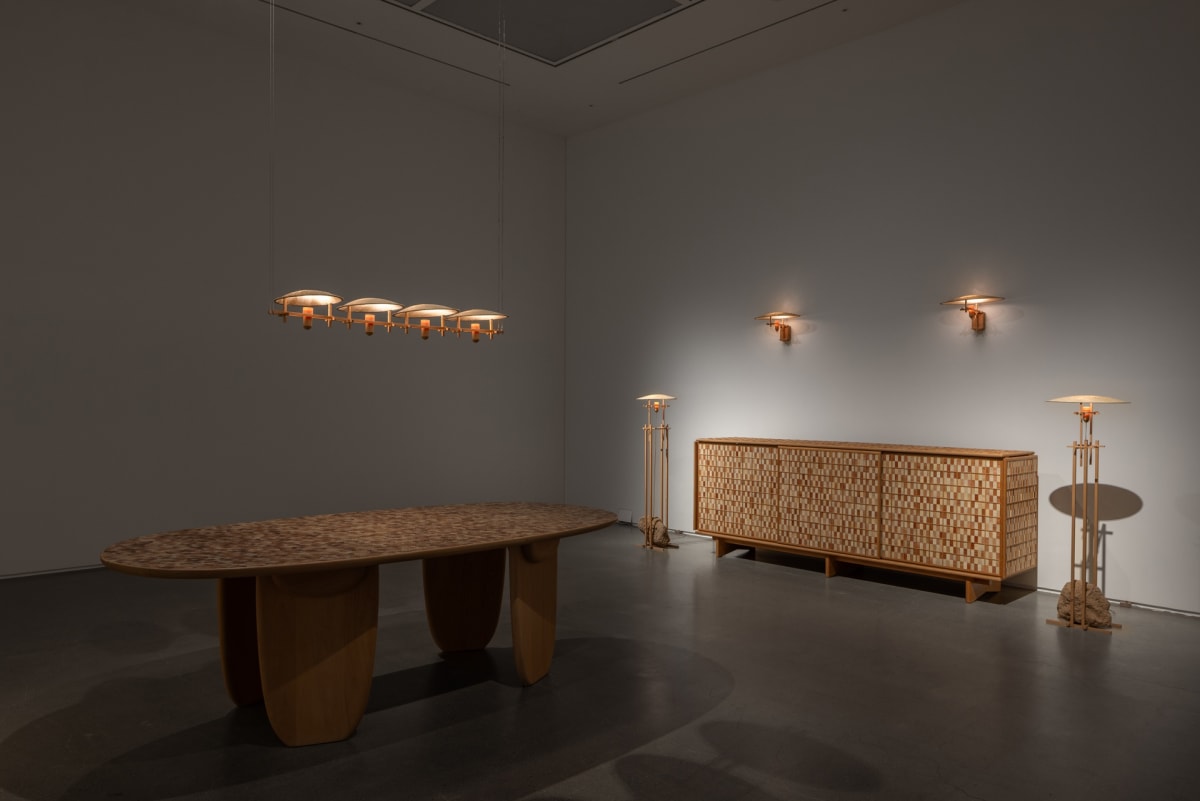Fernando Laposse Mexico, b. 1988
페르난도 라포세(b. 1988, Mexico)는 멕시코 지역의 역사와 전통, 환경적 맥락을 반영한 토착 디자인(endemic design)을 실천하며 현대사회의 환경위기에 대한 지속 가능한 실질적 대안을 제시한다. 작가는 작물 생산 과정에서 버려지는 잎과 껍질과 같은 잉여물을 가구 제작에 적합한 재료로 가공하여 친환경적 재료의 가능성을 확장한다. 그는 옥수수, 아보카도 껍질, 아가베 섬유, 수세미(Loofah) 등 멕시코의 토착작물에 지역문화와 정체성을 반영한 가구와 오브제를 제작한다.
그는 멕시코 남서부의 원주민 공동체 토나후이스틀라(Tonahuixtla)와 세계 최대의 옥수수 생식세포 및 종자 은행CIMMYT와 협력하며, 소외된 지역 사회의 현실을 조명하고 전통 농업 방식의 보존에 힘쓴다. 나아가 환경 파괴, 생물 다양성 상실, 농촌 공동체 붕괴, 글로벌 무역의 부정적 영향 등 복합적인 문제들을 다루며, 디자인이 지역 사회 문제를 해결하는 본질적인 도구로 기능할 수 있음을 보여준다.
페르난도 라포제는 대안적인 재료실험과 멕시코 원주민 공동체와의 협업을 진행하며 옥수수 껍질로 개발한 신소재 토토목슬Totomoxtle 캐비닛과 테이블, 아보카도 씨와 껍질로 제작된 캐비닛, 천연 스펀지 루파loofah로 만든 조명 시리즈, 아가베 잎에서 추출된 섬유로 만든 대형 몬스터 조명 등의 작품을 제작한다. 그는 글로벌 무역과 단기적 자본이익에 기반한 무리한 개발로 생태적 위기에 처해 있는 멕시코 지역에 디자인을 통해 지속가능한 실천적 삶의 방향을 제시한다.
Fernando Laposse practices endemic design, a methodology rooted in the history, traditions, and ecological contexts of Mexico, offering sustainable and tangible alternatives to the environmental crises of contemporary society. By transforming agricultural byproducts such as husks and leaves into materials suitable for furniture-making, he expands the possibilities of environmentally conscious design. His works incorporate native Mexican crops—such as corn, avocado skins, agave fibers, and loofah—into furniture and objects that reflect local culture and identity.
Collaborating with the Indigenous community of Tonahuixtla in southwestern Mexico and with CIMMYT, the world’s largest maize germplasm and seed bank, Laposse highlights the challenges faced by marginalized rural societies while advocating for the preservation of traditional farming practices. His projects address urgent issues such as environmental degradation, biodiversity loss, the collapse of rural communities, and the adverse impacts of global trade, demonstrating how design can function as a vital tool for social and ecological problem-solving.
Through experimental materials research and community-based collaborations, Laposse has developed works such as Totomoxtle—cabinets and tables crafted from corn husk veneers—and cabinets made from avocado seeds and skins, a lighting series using natural loofah, and monumental lamps constructed from fibers extracted from agave leaves. His practice proposes sustainable modes of living in regions of Mexico threatened by ecological crisis, where reckless development driven by global trade and short-term profit continues to destabilize local ecosystems.
-

페르난도 라포세, 멕시코 자연 재료로 만든 지속 가능한 아트 퍼니처
행복이 가득한 집 October 15, 2025< 행복이 가득한 집> 10월 호 P. 167-169 멕시코 자연 재료로 만든 지속 가능한 아트 퍼니처 페르난도 라포세 Fernando Laposse 멕시코 출신 아티스트 페르난도 라포세는...Read more -

더페이지갤러리, 멕시코 디자이너 페르난도 라포세의 한국 첫 개인전,《자연의 첫번째 금은 초록 (The first Gold is Green)》개최
Maeil August 29, 2025페르난도 라포세는 멕시코 지역의 역사와 전통, 환경적 맥락을 반영한 토착 디자인(endemic design)을 실천하며 현대사회의 환경위기에 대한 지속 가능한 실질적 대안을 제시한다. 작가는 작물 생산 과정에서...Read more -

In Mexico, Redefining the Meaning of ‘Farm to Table’
The New York Times June 4, 2025Many people look at avocados and see guacamole. An agave plant is little more than a future shot of tequila, a corn stalk the raw...Read more





